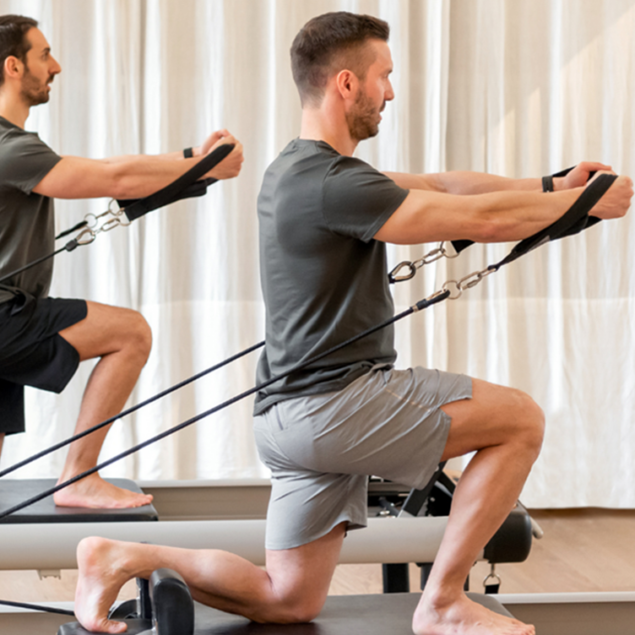
Stepping into your first Pilates class can be nerve-wracking. The equipment might seem complex and the group setting might feel intimidating.
On top of that, if you’re used to more high-intensity workouts, Pilates might appear deceptively simple. The focus on controlled movements and mindful breathing can challenge your idea of what makes an effective workout.
Stepping into your first Pilates class can be nerve-wracking. The equipment might seem complex and the group setting might feel intimidating.
On top of that, if you’re used to more high-intensity workouts, Pilates might appear deceptively simple. The focus on controlled movements and mindful breathing can challenge your idea of what makes an effective workout.
It’s perfectly natural to feel hesitant, but remember, every Pilates practitioner has to start somewhere. In Pilates, it’s all about progress, not perfection.
In this guide, we take a closer look at what Pilates classes are like and the numerous benefits they offer.
Pilates classes typically come in two main forms: mat and reformer. Mat Pilates leverages your own weight and basic props and provides a solid foundation for learning proper form and technique. On the other hand, Reformer Pilates employs a specialised machine known as a reformer, comprising a sliding carriage, springs, straps and pulleys.
Generally, Reformer Pilates classes are the most popular thanks to the reformer. This device enables a broader range of motion and intensity levels than mat exercises alone. Classes provide a dynamic, full-body workout that improves coordination and balance while engaging the powerhouse muscles (hips, glutes, abs and lower back).
For those seeking a more dynamic and challenging workout experience, beginner Pilates classes are a great starting point. Here’s what usually happens during the first few sessions:
Whether you’re looking to improve your posture, increase your core strength or simply for a new way to move, Pilates reformer classes offer a supportive environment for you to start your fitness journey.
Here’s what to expect in a Pilates reformer class for newbies:
The class usually begins with a gentle warm-up to prepare the body for the exercises ahead. This may involve stretches and movements to increase flexibility and circulation.
Most beginner Pilates classes stick to a set of essential exercises that help develop a robust core and enhance performance progressively. These include:
As you become more comfortable with the exercises, your Pilates class can introduce progressions to further make your muscles work. Incorporating props, such as balls or rings, can challenge your stability and boost your coordination.
Muscle soreness is a typical response to Pilates workouts, especially with core-intensive exercises. The minimal yet persistent movement can lead to a significant abdominal burn.
This focused effort often results in delayed onset muscle soreness (DOMS) following your session. Though you might experience some discomfort the day after your initial classes, your body will gradually get used to these movements, reducing the intensity of soreness as you progress.
Soak in a warm bath or use ice packs on sore muscles to ease discomfort and decrease inflammation. Even on days off from full Pilates workouts, take a few minutes to do some gentle warm-up stretches. This can help your muscles recover by promoting the growth of strong, flexible tissue.
The right attire will not only keep you comfortable during your Pilates class but also allow you to perform exercises properly.
Opt for form-fitting pieces like stretchable shorts or soft leggings designed to move seamlessly with you through every bend and stretch. Select breathable materials that wick away moisture, keeping you comfortable and dry throughout the class.
These snug yet comfortable outfits enable both you and your instructor to better observe your movements, allowing for more precise corrections.
When starting a new physical activity, your body faces new movements and pressures, increasing the risk of strains and injuries. Optimise muscle engagement without placing undue stress on joints and ligaments. For instance, aligning your spine correctly helps distribute forces evenly across your body, reducing the risk of strain or overuse injuries.
Selecting a knowledgeable instructor is also essential for ensuring a safe and effective workout experience. At KX Pilates, we offer beginner classes focused on helping you master your technique and form. Trust us to deliver targeted advice to correct misalignments and push your abilities to new heights.
Embark on your path to a stronger, more balanced self with our Pilates classes for beginners. Whether you’re starting fresh or aiming to advance your practice, we offer the right classes for you. These sessions will lay the groundwork for a lifelong journey of fitness and well-being.
Check out our introductory offer and start maximising the benefits of our Pilates reformer classes today.